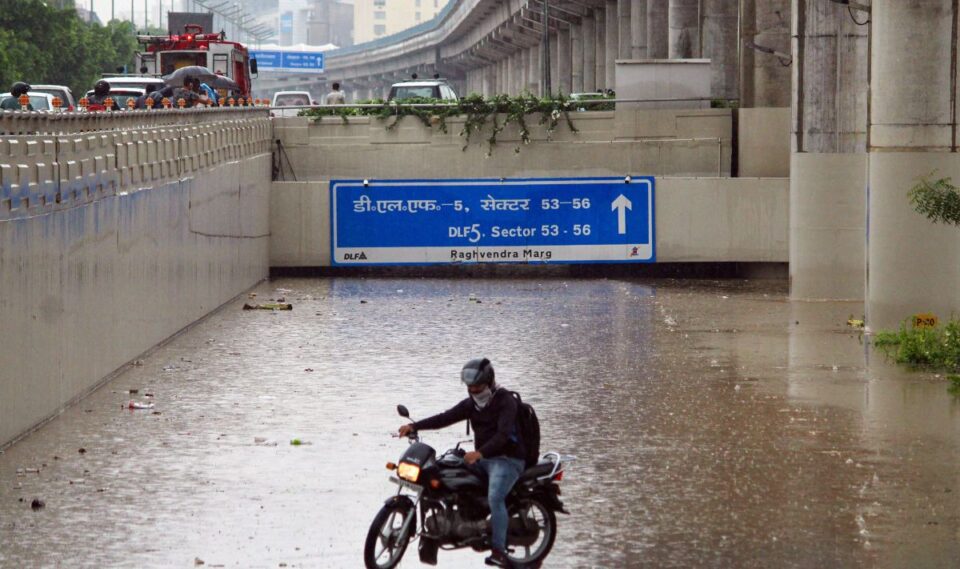Many parts of the national capital and key road stretches remained flooded as rains continued to drench the city on Thursday, triggering traffic snarls during morning rush hours.
IMAGE: A commuter moves through the waterlogged Golf Course Road underpass after heavy rain, in Gurugram. Photograph: PTI Photo
The India Meteorological Department has warned of heavy rains in the city on Thursday as well.
The downpour may lead to “major traffic disruption” due to heavy water logging and there is an “increased chance” of road accidents, it warned.
The Safdarjung Observatory, which provides representative figures for the city, recorded 46 mm rainfall between 8:30 am on Wednesday and 8:30 am on Thursday.
IMAGE: Passersby look at a car submerged in water near the waterlogged Golf Course Road underpass following heavy rain, in Gurugram. Photograph: PTI Photo
On an average, the city gauges 11.3 mm rainfall from 8:30 am on August 19 to 8:30 am on August 20 every year.
The Palam weather station gauged 70.9 mm precipitation during the period, more than six times the normal rainfall.
The Delhi Traffic Police remained busy clearing traffic on Narela-Bawana road, Raja Garden flyover, Kasturba Underpass, MB Rad, Jhandewalan Mandir, Jhilmil underpass,, Azadpur vegetable market, Sarai Pipal Thala, Jahangirpuri, Madanpur Khadar among other places
SEE: Roads of Gurugram submerged
Similar scenes played out on Wednesday, as incessant rains pummelled the national capital region, submerging roads, underpasses and parks in waist-deep water and bringing traffic on key stretches to a virtual halt.
The flooding was particularly severe in Gurugram, where roads turned into small rivers and parks resembled swimming pools.
IMAGE: Vehicles stuck in a heavy traffic jam on waterlogged Delhi-Gurgaon Expressway near Hero Honda Chowk after heavy rains, in Gurugram. Photograph: PTI Photo
Just a few hours of rains flooded swathes of Delhi, spelling trouble for commuters who remained stuck for hours on water-logged roads.
Pictures and videos of vehicles and people wading through waist-deep water were widely shared on social media.
The rains also crippled electricity supply in many areas.
Civic bodies reported incidents of uprooting of trees in a few areas due to the rains.
IMAGE: Men push a car stuck at waterlogged Hero Honda Chowk near Delhi-Gurgaon Expressway after heavy rain, in Gurugram. Photograph: PTI Photo
A boundary wall of a school in Saket collapsed, damaging several vehicles parked alongside it.
Mahesh Palawat of Skymet Weather, a private forecasting agency, said climate change had led to a change rain pattern.
Earlier, we used to witness continuous light rains over two-three days. Nowadays, the same quantum of rainfall occurs in just 2-3 hours. These extreme events have been taking place across the tropical region since last 10 years,” he said.
Experts said the flooding was a result of bad urban planning.
“Flooding in Indian cities is largely a product of bad urban planning. In Delhi, the Yamuna floodplains have been encroached upon obstructing the natural water flow. Other issues include deforestation, poor drainage system and lack of integrated urban planning,” Anjal Prakash, research director, Indian School of Business, Hyderabad, said.
IMAGE: Waterlogged Delhi-Gurgaon Expressway near Narsingpur after heavy rains, in Gurugram. Photograph: PTI Photo
Kuldeep Srivastava,the head of regional forecasting center of the IMD, said the axis of monsoon will remain close to the national capital till Thursday. Therefore, more rains are likely.
Southwesterly winds from the Arabian Sea and southeasterly winds from the Bay of Bengal are also feeding moisture to the region, he said.
IMAGE: Vehicles stuck in a heavy traffic jam on waterlogged Delhi-Gurgaon Expressway near Narsingpur after heavy rains, in Gurugram. Photograph: PTI Photo
The downpour also reduced the rain deficiency in the capital — from 13 percent on Monday to 11 percent on Wednesday.
The Safdarjung Observatory has recorded 147.4 mm rainfall against the normal of 165.2 mm in August so far.
Overall, it has recorded 466 mm rainfall, six per cent more than the normal of 441.3 mm since June 1 when the monsoon season starts.




